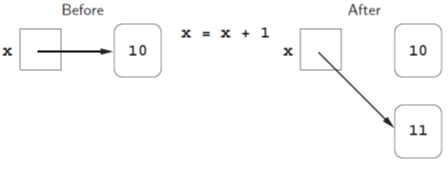1.8. Memory Management in Python#
The way Python handles variables in memory differs from many other programming languages. In some languages, variables act like named storage locations—literal boxes in memory that hold values. When you assign a new value, it overwrites the old one.

In Python, values (objects) live somewhere in memory, and variables are references to those objects. Assigning a variable is like placing a small sticky note on a value that says, “This is x.” This is often called the sticky-note model. In other words, a Python variable is a symbolic name bound to an object (a value with a type at a memory address).

1.8.1. What happens when we execute this statement?#
variable = expression
Execution proceeds as follows:
Evaluate the expression on the right-hand side of = to produce a value (an object with a type and a memory address).
Bind the name on the left-hand side to that object by storing its address/reference in the variable. If the name doesn’t exist yet, Python creates it; if it does, Python rebinds the name to the new object.
Note: The previous object is not “overwritten.” If nothing else references it, it becomes eligible for garbage collection.
1.8.2. Example 1#
difference = 20
double = 2 * difference
print(double) # 40
difference = 5
print(double) # 40 (unchanged, because double already refers to its own value)
Explanation:
After the first two lines,
doublereferences the result of2 * 20, which is40.Rebinding
differenceto5does not retroactively changedouble.
1.8.3. Example 2#
number = 3
print(number) # 3
number = 2 * number
print(number) # 6
number = number * number
print(number) # 36
Explanation:
Each assignment rebinds
numberto a new result; it doesn’t mutate a stored value in place.
You can use Python Tutor to visualize the bindings (the “sticky notes”) as they change: https://pythontutor.com/
